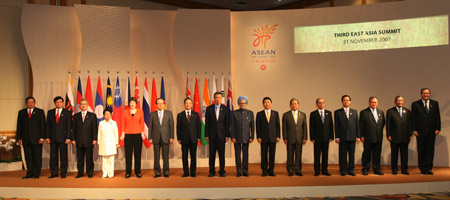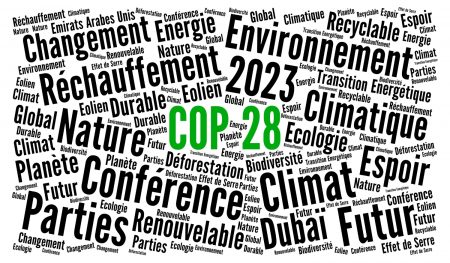私的京都議定書始末記(その11)
-APEC、東アジアサミットでの議論-
有馬 純
国際環境経済研究所主席研究員、東京大学公共政策大学院特任教授
私が担当したエネルギー部分のうち、省エネ目標・行動計画、セクター別アプローチについては、以下のようになった。
Intensify ongoing cooperation to improve energy efficiency….. based on the Cebu Declaration and the Joint Ministerial Statement of the 1st EAS Energy Ministers Meeting on 23 August 2007 by:
- a.
- Working towards achieving a significant reduction in energy intensity;
- b.
- Implementing the measures recommended by the EAS Energy Ministers, including formulation of voluntary energy efficiency goals by 2009….
「セブ宣言や東アジアサミットエネルギー大臣会合の共同声明を踏まえて省エネ協力を強化する」という表現になっているため、共同声明に盛り込まれた要素を全て再掲することはせず、「自主的省エネ目標の策定」が例示された。セクター別アプローチも書き込みたかったが、それも含め、「エネルギー大臣が提唱した方策を実施する」という表現が入ったことで矛を収めざるを得なかった。

しかしAPECと同様、首脳会合に先立つエネルギー大臣会合で合意が得られていることは強みであった。ここでも最も紛糾したのは気候変動の書きぶりだった。将来枠組みに関連するパラグラフを列挙すると以下の通りである。
Stress that all countries should play a role in addressing the common challenge of climate change, ①based on the principles of common but differentiated responsibilities and respective capabilities; and that developed countries should continue to play a leading role in this regard.
Carry out individual and collective actions, in a broad range of sectors, to address climate change, including green house gas emissions, ②considering the principles of equity, flexibility, effectiveness and common but differentiated responsibilities and respective capabilities, as well as reflecting our different social and economic conditions.
Participate actively in the process of developing ③an effective, comprehensive and equitable post-2012 international climate change arrangement under the UNFCCC process.
下線部①ではCBDRと先進国の先導的役割が特筆大書される。下線部②ではflexibility, effectiveness と並んで equity と又してもCBDRが入っている。下線部③の2012年以降の枠組みの形容詞としては、effective, comprehensive and equitable で、equity が再び顔を出す。ハイリゲンダムサミットの 「with a view to achieving a comprehensive post-2012 agreement (post Kyoto-agreement) that should include all major emitters」 と比較すると、「全ての主要排出国の参加」が抜け落ち、equitable が入ったことで、途上国色がより強まっている。 全体としてAPECよりも更に途上国の主張が反映された感がある。議長国が豪州かシンガポールかの違いもあるし、東アジアサミットの事務局的役割を果たすのがASEAN事務局であることも影響していたのだろう。
なお、共有されたグローバル目標については、APECの表現が踏襲された。
Support the work to achieve a common understanding on a long-term aspirational global emissions reduction goal to pave the way for a more effective post-2012 international arrangement
APECと同様、半減目標を含む日本提案を評価するとの一文を入れようと試みたが、途上国側の主張により、共同声明前文の中に以下のような一文が入るにとどまった。
Appreciating the efforts of various East Asia Summit participating countries, including Australia, China, India, Indonesia, New Zealand, Japan and ROK, which have contributed to the global debate to address climate change.
APECでは長期目標に関するパラグラフの末尾に”We appreciate the efforts of Japan and Canada in proposing a long-term global goal” という一文が入り、日本提案が長期目標に関するものであることが明確になっていたが、以下の文章は、長期目標のパラグラフとは別のところに出てくるため、両者の関連性が不明確だ。その上、途上国が「自分たちもグローバルな議論に貢献している」と主張した結果、国名がずらずらと並ぶ形になった。
2007年6月のハイリゲンダムサミットから9月のAPECサミット、11月の東アジアサミットと続く一連の首脳プロセスにおける気候変動関連の議論は、つまるところ12月のCOP13に向けた前哨戦であった。首脳会合で一度採択された表現は前例としてその後の首脳会合やマルチ会合のドラフト交渉にも強い影響を与える。だからこそ、先進国も途上国も必死で自分たちの色を出そうとするわけだ。
私はエネルギー部分担当なので、気候変動部分のドラフト交渉はバックベンチャーとして参加していたのみであったが、「これは先が思いやられる」と感じ、暗澹たる気持ちになった。1ヶ月後にバリ島で開催されるCOP13に資源エネルギー庁から参加することが決まっていたからだ。















 カーボンニュートラル
カーボンニュートラル
 プラスチックリサイクル
プラスチックリサイクル
 エネルギー危機
エネルギー危機




